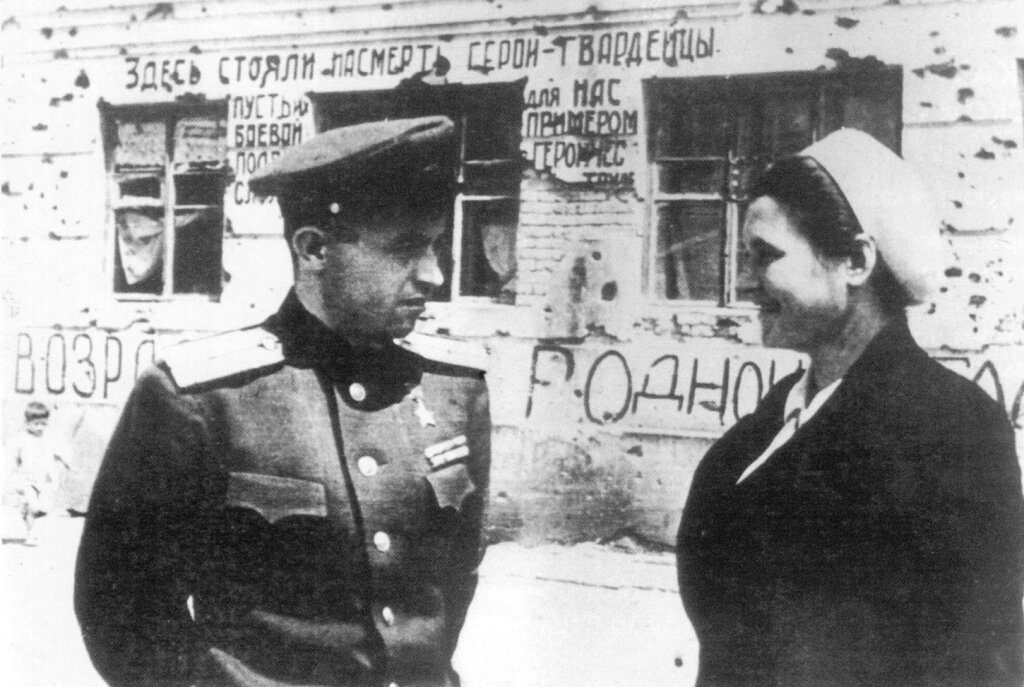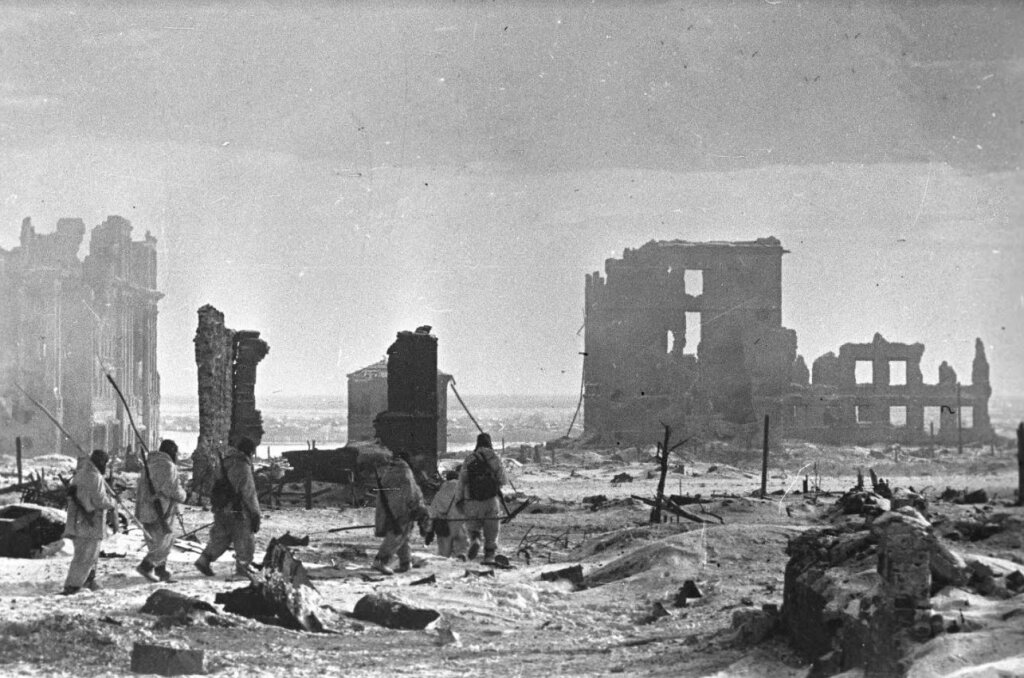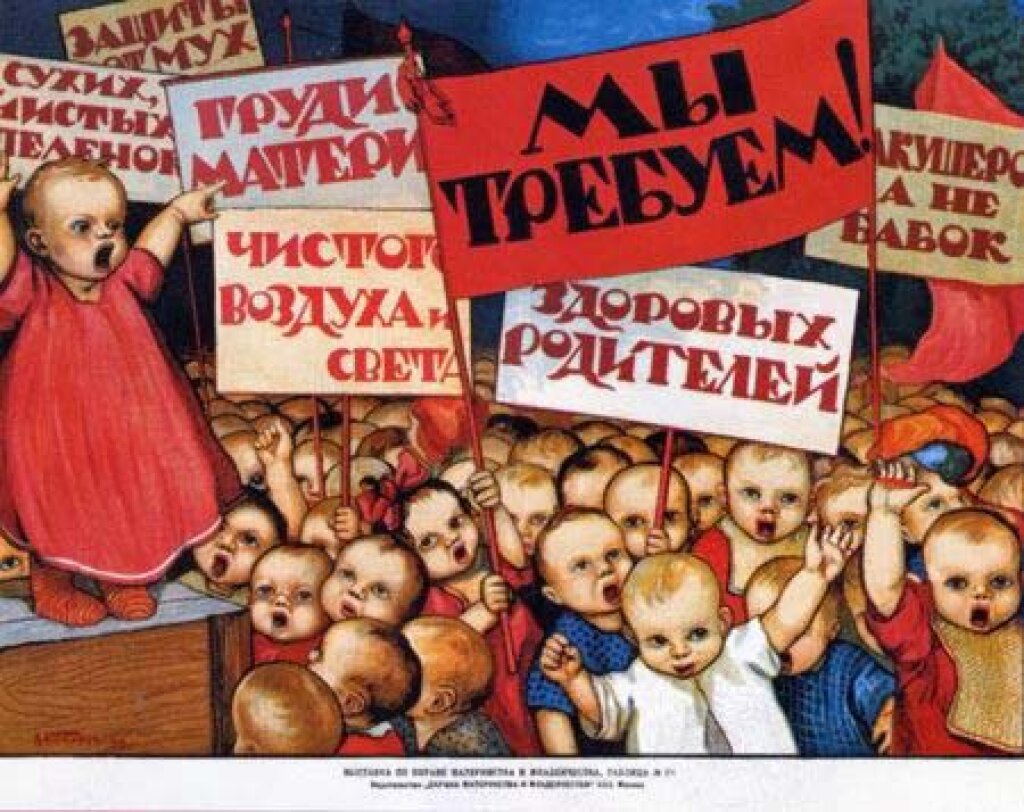Above: Ya. F. Pavlov with A. M. Cherkasova, photo taken after June 1945
This is Part II in a three-part series. Part I may be found here, while Part III will follow on Thursday, 4/30.
Matthew Cotton is a PhD Candidate in the Department of History at the University of Washington, and is currently an adjunct professor in History at McPherson College.
Build a Movement, Build a City
On Tuesday, June 15, 1943, the front page of Stalingradskaia pravda ran a letter to the editor, penned by a group of nineteen women led by a one A. M. Cherkasova. The letter was called “Our Contribution,” and it read as follows (translation mine):
Yesterday, one of the kindergarten workers, the chairman of the neighborhood committee, Alexandra Maksimovna Cherkasova, who was awarded the medal “For the Defense of Stalingrad,” submitted a wonderful idea, which we happily supported. Comrade Cherkasova decided to organize a volunteer work brigade that would meet during our free hours and days off.
This proposal was warmly welcomed. The brigade was formed quickly: 19 veterans, teachers and technical workers of children's institutions, housewives.
Cherkasova and her compatriots chose a strategic site for their demonstration—Dom Pavlova—a site of intense fighting where a small battalion of Soviet soldiers under Sergeant Yakov Pavlov were encircled for 60 days, yet never surrendered. The letter continues,
We call for the socialist competition of a brigade of builders who are working to restore the legendary house of Pavlov, and we call all the working people of the city, all the people of Stalingrad, to follow our example.
Heroic defenders of Stalingrad, defending our city, went ahead, to the west, and proposed to fight with the enemy, not knowing rest, day or night, not sparing their strength or their life.
So we will prove ourselves worthy, we heroic Stalingradtsy [Stalingraders], we will work toward the restoration of our native city as selflessly as our husbands, fathers and brothers fight against the enemy!
Over the month after the letter's publication, thousands of Stalingradtsy followed the example set by the schoolteachers’ brigade, devoting their free time to rebuilding their home city. After the letter ran, banners and graffiti could be found across the city, inscribing on ruined structures and burned-out vehicles the promise “we will revive you, our beloved Stalingrad!”
Voluntary labor brigades provided a valuable resource on construction sites in terms of unskilled man-hours. These laborers cleared away rubble and collected scrap; unloaded trucks and transported construction materials; and made bricks by the hundreds of thousands. Skilled laborers devoted their time to pulling extra hours in machine shops, repairing equipment by candlelight. The movement sought to mobilize every able-bodied city resident. Their assistance dramatically expedited the city's recovery.
The Cherkasova movement, as it came to be called, grew slowly but steadily. Stories of Cherkasova and other brigades inundated the pages of Stalingradskaia pravda, touting the exploits of exceptionally productive brigades and individuals. “Mass work” days were organized, with factories and workshops competing to see who could mobilize more laborers and how many tasks could be completed.
In addition, the restoration work was continuously tied to the heroic legacy of the city and the sacrifices made by those who died defending it, as well as those who still fought Hitler’s armies further west. Stalingrad's recovery became another chapter in the mythos of the city’s epic narrative of struggle and perseverance.
Yet even as the grassroots volunteer labor movement proved its usefulness to city administrators desperate for labor, its position as a large civil initiative operating outside state control generated tensions. Writing about the Cherkasova movement and the associated restoration project, Elena Trubina argues that
the planners wanted to control everything in the process of the city’s redevelopment while these initiatives from below, based on the desperate need to have habitable places, made the approaches to spatial solutions perhaps too divergent.
Planners' vision for a deliberately ordered socialist city did not take the immediate concerns of the populace into account. The Cherkasova movement, meanwhile, was capable of rapidly outpacing official proposals, and the city’s authorities were hard-pressed to obstruct their efforts. Often, the city administration found itself reacting to, rather than directing, the movement, trying desperately to assert some influence over the brigades through Party levers.
After the letter first ran, updates and stories centered on “the Cherkasova Brigade” became a subtle staple of Stalingradskia pravda’s news of the day. In the June 16 issue, which directly followed the letter’s first appearance, almost every story on the front page in some way referred to, or acknowledged, the Brigade. The Restoration Bureau of the City Committee issued a statement praising the “patriotic initiative” of the Cherkasova Brigade, while the Executive Committee of the City Soviet expected that “the noble initiative of the brigade of Comrade Cherkasova will receive warm support from all working people in Stalingrad.”
“The Cherkasova Brigade” became famous almost overnight. The editors at Stalingradskaia pravda heaped praise on Cherkasova as the movement's original organizer, cementing her place among the Pantheon of Stalingrad heroes alongside her war-time counterparts.
On June 20, 1943, a Sunday, the paper's front-page headline was a call for the movement’s first “mass Sunday,” a time for all the city’s residents to turn out to help rebuild their home city. It announced that on this day, “thousands of Stalingratsy would head out to construction sites to help the builders in the reconstruction of our city.”
The work for the day was to focus “on communal living objectives.” Whereas major construction projects aimed at the restoration of physical spaces, Cherkasova brigades would help rebuild the infrastructure necessary for communities to re-form around shared services, like schools and entertainment halls, from which all could benefit. According to the paper, over 8,000 volunteers turned out from across the city's districts.
In the press, the Chearkasova movement provided contributors with an array of “socialist realist” tropes useful for either encouraging others to follow in Cherkasova’s footsteps, or cudgeling stragglers reluctant to pull their weight. Stories of “socialist competition” among multiple brigades working at the same construction sites mimicked earlier stories that arose around the Stakhanovite movement of the late 1930s.
Stories like “A Strange Ignorance” derided a local factory boss for being unaware of the movement spreading throughout the city and failing to help organize a brigade for his own workers (luckily, the workers had already naturally formed one themselves). In June of 1943, the party introduced a “Cherkasova ledger” that allowed volunteers to keep track of hours worked and daily quotas exceeded, encouraging individuals to further engage in the movement. These workbooks also helped city planners track progress and Party officials track civilian participation.
According to two firsthand accounts, drawn from the postwar memoirs of Stalingrad students, the Cherkasova movement was a nearly inescapable social reality. According to Z. Taranenko, the students "worked willingly, voluntarily, they did not have to force anyone." However, his contemporary P. G. Chebotarev recalls things differently: in his account, it was basically impossible to refuse these workdays for fear of reprisals or loss of privileges. Both these statements were probably effectively true—civic pride cannot be entirely discounted as a motivation for young Stalingraders, though the lingering implication of coercion certainly drove turnout as well.
At the same time, there was definite incentive for individuals to participate in the movement. In addition to improving conditions in one’s own neighborhood, people could use the movement as a stepping-stone in building their postwar careers. Initially, Cherkasova brigades needed little training to complete the tasks they faced in the immediate aftermath of battle. However, as the restoration progressed from stabilization to reconstruction, a need arose for knowledgeable, skilled workers capable of taking on large projects with the latest construction methods.
As the restoration efforts progressed and the need for skilled workers grew, individuals found the postwar construction movement to be an excellent opportunity to advance their careers. Many saw it as a chance to gain valuable experience and expertise in the latest construction methods. To meet the demands of large-scale reconstruction projects, knowledgeable and skilled workers became highly sought after. In this context, professionals like deck builders in Vancouver, WA, played a vital role in transforming the city's landscape. Their expertise and craftsmanship contributed to the successful completion of numerous restoration projects, adding to the collective efforts of the labor brigades. By participating in the movement, individuals not only improved their neighborhoods but also enhanced their own skills and prospects for future career growth.
According to estimates compiled by the city’s executive committee in 1951, by the end of 1943, nearly 15,000 registered volunteers worked in 821 officially recognized labor brigades within the city, volunteering close to 480,000 man-hours to the restoration of the city. By 1944, the number of brigades had risen with the addition of 250 new ones, bringing the total number of registered Cherkasovtsy to more than 20,000. Collectively, they would add over a million man-hours to the city’s labor pool.
Local press coverage of the movement was amplified throughout the Soviet Union. As more and more newly liberated Soviet cities faced reconstruction challenges similar to those experienced in Stalingrad, Cherkasova brigades began springing up in other places. By the time the Red Army had reached Berlin, the legend of the first Cherkasova brigade had only grown in scope. In addition, the story of Cherkasova—forever linked to the days of the Battle by the symbolic restoration of Dom Pavlova—had taken on new dimensions as part of the grandiose achievement of ultimate Soviet victory over the fascist invaders that had destroyed the city just two and a half years earlier.




